The Power Of X
A simple yet powerful lighting technique anyone can master in under a minute.
The lights listed below are from NAB 2015. We have posted the NAB 2016 results — every brand of LED light at the show, over 160 lights from 65 brands — in our new LED Color Quality database, since we used a more advanced spectrometer. We recommend checking out that database for all of the current LED lights on the market.
The 2015 database is still a very good resource for those purchasing LED lights made during that year. Since LED technology is continually improving, current generations of lights will most likely be higher quality than previous generations of LED lights, such as those listed below. This most likely explains why the below data may not agree with measurements from current models, even if the model has the same name. What is important is the LED diode/emitter within the light fixture, which most likely is regularly updated.
Results are arranged by average Extended CRI values (R1 through R15).
Measurements were taken with a Sekonic C-700 Color Meter. Values for R9, R13, and R15 are listed because they are important for proper skin tones, yet LEDs tend to not render them correctly.
*Color readings marked with an asterisk (*) were taken in our controlled environment, a completely black studio with no other light source other than the LED being tested. All other lights were tested at NAB 2015. (We explain our testing procedures here.)
 Price (USD): $3036 (Amazon) |
Lumos 500MK Product Page (Measured 4/2015)  |
|||
| CRI | Extended CRI | R9 | R13 | R15 |
| 97.2 | 96.2 | 90.0 | 97.4 | 96.0 |
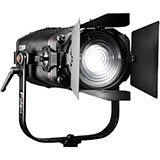 Price (USD): $3495 (B&H Photo) |
Fiilex Q1000 Product Page (Measured 4/2015)  |
|||
| CRI | Extended CRI | R9 | R13 | R15 |
| 96.7 | 95.6 | 91.5 | 96.3 | 94.2 |
 Price (USD): $599.90 (Amazon) |
Westcott Flex* Product Page (Measured 6/2015)  |
|||
| CRI | Extended CRI | R9 | R13 | R15 |
| 96.0 | 94.2 | 94.2 | 97.8 | 96.0 |
 Price (USD): $2828 (Amazon) |
Arri L7-C Product Page (Measured 4/2015)  |
|||
| CRI | Extended CRI | R9 | R13 | R15 |
| 94.2 | 93.8 | 95.5 | 95.8 | 96.2 |
Price (USD): ?? (NanGuang) |
NanGuang CN200F Product Page (Measured 4/2015) 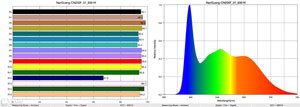 |
|||
| CRI | Extended CRI | R9 | R13 | R15 |
| 95.1 | 93.6 | 95.5 | 99.1 | 94.2 |
 Price (USD): $278 (Amazon) |
Aputure Amaran HR672S* Product Page (Measured 11/15)  |
|||
| CRI | Extended CRI | R9 | R13 | R15 |
| 96.0 | 93.2 | 90.7 | 98.8 | 95.6 |
Price (USD): ?? (NanGuang) |
NanGuang 2×2 Product Page (Measured 4/2015)  |
|||
| CRI | Extended CRI | R9 | R13 | R15 |
| 95.4 | 92.9 | 93.5 | 99.2 | 96.7 |
 Price (USD): $848 (Adorama) |
Film Gear 4’ LED Flo-Single Product Page (Measured 4/2015)  |
|||
| CRI | Extended CRI | R9 | R13 | R15 |
| 94.3 | 92.9 | 95.2 | 95.0 | 91.5 |
 Price (USD): $1,485 (LiteGear) |
LiteGear LiteMat 2 Product Page (Measured 4/2015) 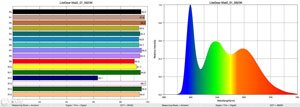 |
|||
| CRI | Extended CRI | R9 | R13 | R15 |
| 95.2 | 92.8 | 90.3 | 98.7 | 94.0 |
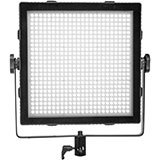 Price (USD): $949 (B&H Photo) |
Dedo Felloni Product Page (Measured 4/2015)  |
|||
| CRI | Extended CRI | R9 | R13 | R15 |
| 94.8 | 92.7 | 90.6 | 97.4 | 95.2 |
 Price (USD): $2350 (Amazon) |
Cineo Maverick Daylight Product Page (Measured 4/2015)  |
|||
| CRI | Extended CRI | R9 | R13 | R15 |
| 94.3 | 92.6 | 93.2 | 96.2 | 92.4 |
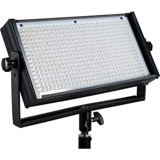 Price (USD): $599 (B&H Photo) |
FloLight MicroBeam 512 Product Page (Measured 4/2015) 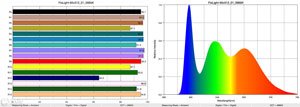 |
|||
| CRI | Extended CRI | R9 | R13 | R15 |
| 95.1 | 92.5 | 95.2 | 98.9 | 94.8 |
 Price (USD): $495 (Amazon) |
Cineo Matchbox Product Page (Measured 4/2015)  |
|||
| CRI | Extended CRI | R9 | R13 | R15 |
| 94.3 | 92.4 | 91.5 | 95.6 | 92.7 |
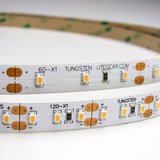 Price (USD): $36 (LiteGear) |
LiteGear Ribbon VHO PRO Product Page  |
|||
| CRI | Extended CRI | R9 | R13 | R15 |
| 94.6 | 92.1 | 88.6 | 99.3 | 94.6 |
 Price (USD): $4016 (Amazon) |
Cineo TruColor HS Product Page (Measured 4/2015)  |
|||
| CRI | Extended CRI | R9 | R13 | R15 |
| 94.0 | 91.7 | 88.1 | 94.3 | 92.4 |
 Price (USD): $480 (Amazon) |
Dracast LED500 Product Page (Measured 4/2015)  |
|||
| CRI | Extended CRI | R9 | R13 | R15 |
| 94.6 | 91.5 | 81.7 | 94.1 | 89.5 |
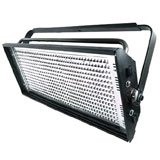 Price (USD): ?? (FluoTec) |
FluoTec Stage Maker Product Page (Measured 4/2015) 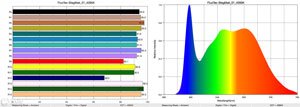 |
|||
| CRI | Extended CRI | R9 | R13 | R15 |
| 93.9 | 91.5 | 82.1 | 96.3 | 95.3 |
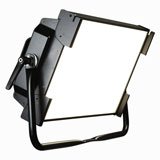 Price (USD): $2800 (B&H Photo) |
Ushio ProPanel V2 Product Page (Measured 4/2015) 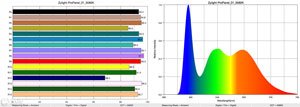 |
|||
| CRI | Extended CRI | R9 | R13 | R15 |
| 93.4 | 91.3 | 95.0 | 95.5 | 92.7 |
 Price (USD): TBD (MacTech) |
MacTech Artist Series Bi-color Product Page (Measured 4/2015) 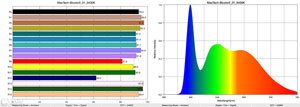 |
|||
| CRI | Extended CRI | R9 | R13 | R15 |
| 93.4 | 90.7 | 81.2 | 97.0 | 93.4 |
 Price (USD): $6250 (B&H Photo) |
Arri SkyPanel Product Page (Measured 4/2015) 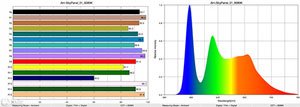 |
|||
| CRI | Extended CRI | R9 | R13 | R15 |
| 93.7 | 90.6 | 91.0 | 99.1 | 97.6 |
 Price (USD): $199.95 (Amazon) |
FotoDiox Pro FlapJack Product Page (Measured 4/2015) 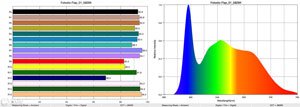 |
|||
| CRI | Extended CRI | R9 | R13 | R15 |
| 92.8 | 90.4 | 82.5 | 94.2 | 95.4 |
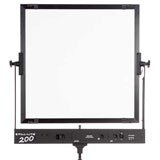 Price (USD): $2450 (Fill-Lite) |
Fill-Lite 200 Product Page 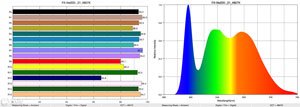 |
|||
| CRI | Extended CRI | R9 | R13 | R15 |
| 93.4 | 90.3 | 80.1 | 95.4 | 94.7 |
 Price (USD): TBD (MacTech) |
MacTech Daylight 4’ Tube (2015) Product Page (Measured 4/2015) 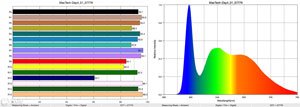 |
|||
| CRI | Extended CRI | R9 | R13 | R15 |
| 93.1 | 90.2 | 84.1 | 96.1 | 96.3 |
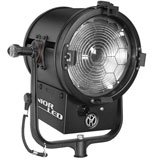 Price (USD): $2089 (B&H Photo) |
Mole Richardson JuniorLED 200 Product Page (Measured 4/2015)  |
|||
| CRI | Extended CRI | R9 | R13 | R15 |
| 91.6 | 89.4 | 72.3 | 95.9 | 89.7 |
 Price (USD): $1324 (Amazon) |
LitePanels Astra Bi-Color* Product Page (Measured 2/2016) 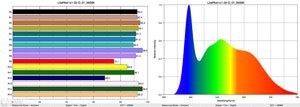 |
|||
| CRI | Extended CRI | R9 | R13 | R15 |
| 92.4 | 89.3 | 75.1 | 93.3 | 92.5 |
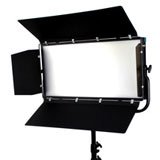 Price (USD): $1799 (Intellytech) |
Intellytech Socanland D100 Bi-color Product Page (Measured 4/2015)  |
|||
| CRI | Extended CRI | R9 | R13 | R15 |
| 92.7 | 89.2 | 69.9 | 91.0 | 85.2 |
 Price (USD): $2840 (Amazon) |
Kino Flo Celeb 200 DMX* Product Page (Measured 4/2015)  |
|||
| CRI | Extended CRI | R9 | R13 | R15 |
| 91.6 | 89.0 | 89.0 | 96.4 | 98.3 |
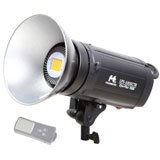 Price (USD): $433 (Benel) |
Falcon Eyes/Linkstar LPS1000 Product Page (Measured 4/2015) 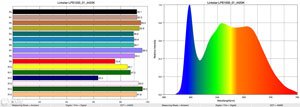 |
|||
| CRI | Extended CRI | R9 | R13 | R15 |
| 92.1 | 88.8 | 75.8 | 93.2 | 91.8 |
 Price (USD): $9.39 (Amazon) |
Cree TW (2700K)* Product Page (Measured 4/2015)  |
|||
| CRI | Extended CRI | R9 | R13 | R15 |
| 91.4 | 88.5 | 61.9 | 91.9 | 88.6 |
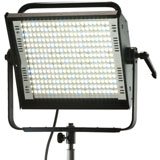 Price (USD): $1428 (B&H Photo) |
Lowel Prime Product Page (Measured 4/2015)  |
|||
| CRI | Extended CRI | R9 | R13 | R15 |
| 90.2 | 86.6 | 62.3 | 92.2 | 89.1 |
 Price (USD): $579 (B&H Photo) |
Lowel Pro Power LED Product Page (Measured 4/2015)  |
|||
| CRI | Extended CRI | R9 | R13 | R15 |
| 90.0 | 86.6 | 63.3 | 90.1 | 89.4 |
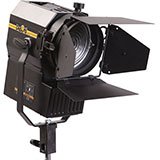 Price (USD): $1890 (B&H Photo) |
Desisti Magis Product Page (Measured 4/2015) 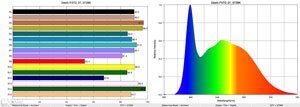 |
|||
| CRI | Extended CRI | R9 | R13 | R15 |
| 90.0 | 86.6 | 53.4 | 93.0 | 87.7 |
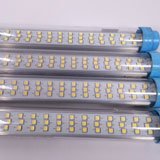 Price (USD): $95 (old model, each tube) |
MacTech 1’ Daylight Tube (old model)* Product Page (Measured 4/2015) 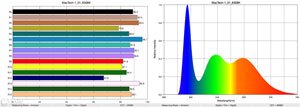 |
|||
| CRI | Extended CRI | R9 | R13 | R15 |
| 89.2 | 86.6 | 81.9 | 93.9 | 88.1 |
 Price (USD): $199 (old model, each tube) |
MacTech 4’ Daylight Tube (old model)* Product Page (Measured 4/2015)  |
|||
| CRI | Extended CRI | R9 | R13 | R15 |
| 89.4 | 86.5 | 71.6 | 86.0 | 81.6 |
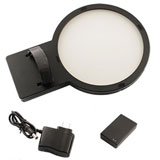 Price (USD): $99 (Color Right) |
ColorRight Lumenator* Product Page (Measured 4/2015) 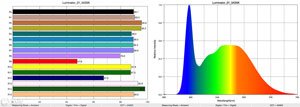 |
|||
| CRI | Extended CRI | R9 | R13 | R15 |
| 89.7 | 86.1 | 47.8 | 92.8 | 89.6 |
 Price (USD): $125 (old model, each tube) |
MacTech 2’ Daylight Tube (old model)* Product Page (Measured 4/2015)  |
|||
| CRI | Extended CRI | R9 | R13 | R15 |
| 85.9 | 82.1 | 55.9 | 87.8 | 78.7 |
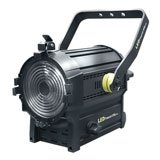 Price (USD): ?? (FluoTec) |
FluoTec Fresnel 650 Product Page (Measured 4/2015) 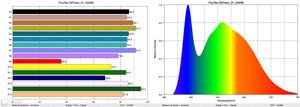 |
|||
| CRI | Extended CRI | R9 | R13 | R15 |
| 86.2 | 81.2 | 36.0 | 85.5 | 81.8 |
 Price (USD): $970 (B&H Photo) |
Rosco LitePad Vector Product Page (Measured 4/2015) 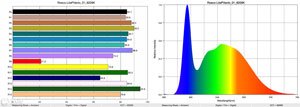 |
|||
| CRI | Extended CRI | R9 | R13 | R15 |
| 84.7 | 79.0 | 21.0 | 84.6 | 79.8 |
 Price (USD): $4.97 (Amazon) |
Philips SlimStyle LED, Dimmable* Product Page (Measured 4/2015)  |
|||
| CRI | Extended CRI | R9 | R13 | R15 |
| 84.5 | 78.8 | 21.6 | 86.0 | 79.7 |
 Price (USD): $179.99 (Amazon) |
Bestlight 900 LED* (Measured 4/2015) 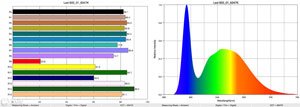 |
|||
| CRI | Extended CRI | R9 | R13 | R15 |
| 82.1 | 76.3 | 20.6 | 83.0 | 81.1 |
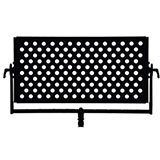 Price (USD): $4500 (MacCam) |
Creamsource Bender Product Page (Measured 4/2015)  |
|||
| CRI | Extended CRI | R9 | R13 | R15 |
| 79.5 | 72.4 | 1.4 | 78.1 | 72.2 |
 Price (USD): $749 (B&H Photo) |
Lime Lite Mosiac Bi-Color* Product Page (Measured 4/2015)  |
|||
| CRI | Extended CRI | R9 | R13 | R15 |
| 70.8 | 59.6 | -41.3 | 67.4 | 56.8 |
Hi Ryan,
Thanks for testing all these lights. We’ve been looking at investing in a new set of LEDs and we were looking at a the Litepanels Astra, but after seeing your data I am not so sure. What are your recommendations for a set of lightweight, high output LEDs that produce great color?
Yeah, based off of these test, and what I’ve heard and seen from others, I would consider something else.
Personally, I would seriously look into the LED’s from LiteGear. Not only can you “build” your own high quality lights for very affordable prices. But you can also buy their pre-made LED’s which are thin and lightweight. The people behind LiteGear work in the industry as Gaffers- so I know they’ve build there gear to withstand the rigors of set use.
Another light I would look into would into would be the Aperture or the Wescot Flex. Both of those are small, light, and super portable. I haven’t used the Aperture, so I cannot speak from experience. My only concern would be how well it will hold up over the long haul. The Flex has worked well so far, and I like it. The one issue I have with it, is the small ball mount that connects to the clamp for stand mounting. In past experience, that never holds up well long term. I’m hoping that isn’t the case with this one- but I’ve only had the light since NAB 2015, so we’ll see how it goes…
Another light I would recommend would be the Fill-Lite. I LOVE the soft quality it puts out, high output, good color, low power draw. However, it isn’t near as small and portable as any of the lights I previously recommended. If you have worked with the Kino Celeb before- the Fill-Lite is roughly as big and heavy as that light, but better color quality.
Hope that helps. 🙂
Hi Ryan, Ted here from Aputure. I manage the US branch of the company and I’d like to send you a sample unit of our lights, so you can speak from experience about our gear. We’re new to the spotlight, but not new to LED lighting and I’d like for you to see that for yourself! Please message me.
Ted,
Thanks. I’ll send you an email shortly. I look forward to checking out your lights.
What is the TLCI reading of the Aputure Lightstorm??
The Aputure Lightstorm 1S has a TLCI of 96.7, while the Aputure Lightstorm 1/2w has a TLCI of 98.1. These results are from my most recent color readings, which I took at NAB in April 2016.
I’m curious, with the Litepanels Astra, were you measuring on daylight or tungsten? And for that matter, I’m assuming you would have been consistent with all the other bi-color LEDs? I’ve found on the Astras that the 2700K readings are more accurate than daylight.
The measurements for the Litepanels Astra on this page are for daylight (5936K) and was measured in 2015. We updated the entire database last year (2016) and the Astra’s color quality greatly improved. Our results can be seen here: https://indiecinemaacademy.com/complete-led-color-database-cri-tlci-cqs-tm30-15/#litepanels-astra-1×1 We will be retesting the Astra again this year (2017) at NAB, assuming that Litepanels shows the light.
Many LEDs have more accurate color rendering for tungsten balanced CCTs than the daylight balanced CCTs, and Astra is an example of this. So it for tungsten balanced it is around 3-4 units higher than daylight balanced.
Its my understanding barger-lite is and has been used by DP and best boy production teams for many years. The website is http://bargerlite.com Hope this helped.
Matthew T.
Thanks. Yes, we have it up on our new LED database. We ranked the Barger Lite at 98.0.
Hi Ryan,
You and I are of like mind, or maybe I should say you are as big a lighting nerd as I am 😉
For the past 3-years I’ve been taking CRI reading at trade events around the world. It’s part of the reason that my company only stocks and sell certain LED lights and not others. I watched your video and have to disagree that a broadcast prism is a sufficient reason for discounting the relevancy of TLCI. Rather than go down the rabbit hole of reconstruction of RGB from 3-sensor imager, I’ll just say that cameras that feature a prism have been used to shoot major motion pictures, been nominated for ASC awards and won BAFTAs for best cinematography. I also counter that not all single CMOS sensor cameras have equal spectral response to the visible spectrum. This is no more a penalty then a prism in a so-called broadcast camera. IMHO I’ve found that TLCI readings to be far more accurate than CRI including extended CRI, although a TLCI meter is much harder to source (at least today.)
The importance to a handful of categories of CRI/extended CRI is an over simplification of the problem. Yes, you most definitely want a high quality response, across all color categories/samples, but ultimately the balance and quantity of each category at a given color temperature is very important, this is why a lower quality light can sometimes match quite well with a higher quality (or even full spectrum) light. Not suggesting that you ever want a low quality light (you really don’t) but the question of rating the quality of light gets even more complicated. I direct your attention to an oldie but goodie you should be aware of; it was produced a few years ago by AMPAS, the Academy of Motion Pictures Arts and Sciences. While this gets into the deep end it still very much holds water today. AMPAS correctly makes the case that the individual cameras and make-up are also factors in results of skin tones with solid state lighting. Here’s a link,
http://www.oscars.org/science-technology/sci-tech-projects/solid-state-lighting-project
In going back to TLCI, I also have enjoyed the BBC TLCI testing results which you can find here:
http://www.gtc.org.uk/tlci-results/tlci-results-new-format.aspx
Ultimately a meter reading is great start and you can see some relationship between CRI and TLCI, but I have to hand it to TLCI as a superior scale to understand the overall quality of the light.
I also think it’s important for your CRI blog that you take readings of traditional industry standard lighting instruments generally accepted as a “high quality” or “full spectrum” lights. I suggest taking readings from all the big name HMI manufacturers and fluorescents, you’ll get an even better understanding of the relationship between what kind of light is acceptable and what is crap. I won’t spoil the result, but I’m certain you’ll find the results interesting.
Illya Friedman
President
Hot Rod Cameras
http://www.hotrodcameras.com
Thank you Illya for all your thoughts about CRI vs TCLI. Great information for everyone. I highly recommend people checking out your links.
As you said, not all single CMOS sensors respond the same to light (not only visible, but IR too!) This is a great reminder of the importance of doing camera tests before production, and including the lights you plan to use in those tests.
Great suggestion to include other light sources in our tests, including HMIs and fluorescents. That has been the plan. Understandably, just testing 44 lights at NAB and then analyzing the data took some time. Adding in HMIs, fluorescents, plasma, etc would have tied us up for the entire week of NAB! 😉 Soon!
Illya,
Yep- we are definitely lighting nerds for sure. 🙂 I love the power this kind of testing gives the end use- knowing where lights suffer, and where they excel allows for smarter choices on set.
I also REALLY appreciate the quality products you represent and sell through your store. If anyone is looking for a store that only reps quality products, and also has GREAT customer service and FANTASTIC knowledge about each product, I can say from experience, that I definitely recommend checking out Hot Rod Cameras. 🙂
I appreciate the link to the solid state lighting project- I’ll definitely check that out.
For me, one of the most telling demonstrations between prism based cameras and non-prism based cameras it the side by side comparison between the Varicam 35 (non-prism) and the Varicam HS (Prism) in Geoff Boyle’s test:
http://www.cinematography.net/cml-uwe-2015.html
Art Adams did an excellent write up showing the two side by side:
http://www.provideocoalition.com/tlci-and-camera-color-what-a-difference-a-prism-block-makes
Personally, I think the results speak for themselves. The prism block changes the way the camera sees light, which changes the results. So I’m doubtful of a standard that relies on prisms to be used for non-prism based cameras. Like I said in the CRI video– it doesn’t negate TLCI, that’s still a helpful standard.
To complicate the issue further, every camera (prism or non-prism) sees light differently since it has its own color science and special sauce. Which is why I think both of us would agree that at the end of the day, the real proof is in an actual test with the camera of choice and the light of choice lighting a scene. 🙂
At the end of the day, I’m not convinced Extended CRI is the best option either- it’s just my preference until one standard is agreed upon. We’ll see what happens… right now the only meter I have that will give me ALL readings (CRI, Extended CRI, TLCI, CQS, and more) is the Lighting Passport…
Oh, and as for comparing other big name manufactures lights, we’ve done that with HMI’s & Tungsten. The tungsten results on the previous page are from a 5k Arri Fresnel. The only light I haven’t tested has been an Kino Flo, since I haven’t been using those in a while. So I guess I should make that a priority. Thanks for the suggestion. I’m always interested in learning more and upping my game. 🙂
As always, I appreciate what you bring to the table and how you add to the film community. 🙂
HI Ryan,
Thanks for the kind words. I’ve met Art Adams I have had the pleasure of debates with him both in person and on-line on more than one occasion. I also had the pleasure of meeting Alan Roberts in person on one occasion, at which time I grilled him pretty heavily on his conclusion in regards to the practicality of high frame for capture and playback (60-150fps). But that’s a conversation for another time. So for transparency, I guess if Art is an acquaintance of mine then Alan would be even less so. I do not agree with everything Alan publishes, but I can tell you after reading Art’s blog, I’m inclined to side with Alan on this.
I’m not saying there aren’t difference in the color rendering of the HS and V35 Varicams, clearly there are- but I greatly disagree with conclusions that Art has drawn, in which all blame is laid at the prism and that extrapolating that TLCI must be fundamentally flawed because of the inclusion of a prism. Besides a prism there are many other difference between the HS and V35 heads.
Both Varicam camera heads have different sensors and are designed for different purposes. They are far from identical and I’m not convinced that the level of a super exact saturation match was a priority for the engineers at Panasonic. The V35 and the HS are both descendants of the famed Varicam family, which most people who know those cameras know had a great look, but the Varicam was also a chameleon that could work amazingly for almost any situation and had(or has for those still shooting them) the ability to deliver several great looks with only adjustments to a few key menus.
If an exact saturation match was a real priority for the factory, they could have made it an entirely achievable match in camera, instead of the relatively minor step required in post production, or via connecting two cameras to a remote paintbox for an on-set match. Ultimately I think Art’s point of a non exact match is actually being used to justify his blog rant against TCLI from months earlier, but the differences between heads are not radically different and certainly no smoking gun.
Geoff shoots good tests, tests I really enjoy, but I’m fairly certain that Art wasn’t present and he doesn’t know for certain how both of the Varicam heads were configured (and probably not recorded or processes.) My feeling is that you have to do it yourself to really know for certain. I bring this up not because I believe Geoff made any mistakes, only that Art has a further level of removal from the process. I didn’t comb through all the discussion on the CML, so it may have been included there, but the exact recording method and camera settings that could effect color rendering weren’t printed on the test page, so it could make an exact duplication of his test difficult- but still it’s not hard to create your own apples to apples test. Art’s conclusions are not based on his own test, they are based on Geoff’s. I do have a number of issues with the results of Geoff’s test, but as I wasn’t present so I don’t feel that my own criticism are appropriate, just as I don’t think Art’s conclusions are either. I’ve been shooting with the V35 for sometime, and I have to say that both with testing and in subjective shooting I am seeing and counting at least 2x stops more of highly useable and DR than Geoff claims in his test results, so clearly IMO there is a discrepancy somewhere.
Art has taken to picking on TCLI, but I believe he does so at his own peril. Art has valid point as to ways that TLCI could be a BETTER standard than it ended up being, but it does not mean that TLCI isn’t the stand out best of the bunch available. It covers the most samples and takes into account (admittedly a blending of cameras) but at least a theoretical reference that is somewhat weighted to what’s important- even if that is not 100% apropos to the camera you are using (most assuredly not anyone’s ever), and even if it isn’t based around an easy to use DSC labs chart, it at least gives you more information than the other systems that exist. It also give you reference against what is probably the most photographed chart for motion picture film, and even though that chart wasn’t perfect, it had been used as a reference for timers and colorists for decades (not defending it, just stating a fact, Macbeth it is a known entity.)
A lot of LED lights have trouble with R12. Is it arguably the most important portion of the spectrum? Debatable- but lights with very good R12 definitely look better to my eye, particularly lights that are supposed to be daylight balanced. I’m curious to follow what daylight lights you’ve tested and meter aside, what you think looks to eye like the best for 5000-6000 kelvin light. I definitely have my picks, and right now I can not say that my favorite is an tradition HMI unit.
Keep up the good work!
I.
Thanks for the info Ryan. What are your thoughts on the Dracast 1000? I noticed the 500 scored quite high on your test.
Anytime- always glad to help. 🙂
honestly for the Dracast, or any other light that isn’t made by someone who actually works in the film industry (Like LiteGear, Fill-Lite, Kino, Mole, Arri…) my question is always how long will the light last- is it built to withstand rough use on set. Color quality and output seem to be great- but I don’t know how long it will hold up. If you are only looking for a light for the short term (1 – 3 years) it looks, and feels like it will hold up. But if you are looking for a longer term investment- I don’t know- only time will tell.
That is the one down side of testing all of these lights at NAB- I couldn’t put them to use in a real working environment …
So… Do you think it’s better to pick lights which meter close R9, R13 and R15 ratings, or just get the one that has an overall bigger sum of those? Asking out of curiosity, because in RL you’ll probably end up picking your favorites anyway 😉
Kinopasha,
That is a great question. I think you’re right in that in real life you’ll end up picking your favorite anyway. But I think I personally will favor the lights that have an overall bigger sum of R9, R13, and R15. (Unless for some reason the R9 value is really low. In that case, I wouldn’t reconsider that LED.)
Would like to see the Aputure LightStorm LS1 and LS1/2 to be tested.
We are in the middle of testing those very lights, plus a few more. Stay tuned!
Dear MR Ryan
i want to understand what does it indicate the Ra till R15 and is there a link explain in much more detail ?
We briefly go over CRI in our article “Is CRI Relevant In An LED World?”
R1 through R15 are 15 colors selected in an attempt to evaluate the color quality of a light source. The Ra value is the average of all 15 colors.
If you want to read up more about CRI, here are some good links:
* Lighting Resource Center: What is color rendering index?
* Lowel: Color Temperature & Color Rendering Index DeMystified
* Digi-Key Electronics: What Is the Color Rendering Index and Why Is It Important?
First, thanks for putting this together. Manufacturers often give us the bare minimum of information to make an informed decision. I’m hoping you’ll have a chance to test Alzo’s LED instruments, specifically the new (low noise model) Alzo 3200 high-intensity LED light.
Thanks, Oren. Yeah, I think everyone has issue with manufacturers not giving out the crucial info. I mean, when have you ever heard someone say, “That product maker gave me too much info about their product.” Very frustrating, especially when getting high quality light from LEDs is so important.
We’ll see what we can do with testing the Alzo 3200. No promises, since we have a bunch of other reviews we’re working on. Thanks for pointing us to them.
Very curious to see if you could test the newer Westcott Flex 1×1’s or 1×2’s to see if they yield the same results as the older, original 10 inch Flex you have tested. It’s been nearly a year between these models, maybe they’re the same but i’m hoping they may have had a chance to improve on that mediocre R9 value… Thanks!
In looking at Westcott’s description of the Flex 1×1 and Flex 1×2, I’m going to guess that they are using the same emitters as the Flex 10″ x 10″. On all three of these products they list the same CRI (95) which is what we measured too. If the R9 value had improved, the CRI value would also have improved.
We are currently testing some other brands of LEDs, and are getting some amazing readings. Not to spoil the surprise, but I recommend looking at Aputure and Yuji brands. Aputure has great R9 values, especially in their Light Storm line. Yuji’s VTC line of emitters is phenomenal, although they don’t have traditional set-lights.
As Tim mentioned, the 1×1’s and the 1×2’s use the same LED’s as the Flex light we have posted above. The Flex light readings were taken at NAB 2015, and I took readings of the 1×1 & 1X2 while I was there too. The results were almost exactly the same. (They varied by less than 0.05- which is why we didn’t post those results.)
The funny thing, however, is that the sample we got sent 2 months later AFTER NAB 2015 does show a marked improvement in the R9 reading. But the Flex light is not marked in any different way, so the end user doesn’t know what version (if any) they are getting. (Or it could just be part of the quality control of that run of LEDs, I’m not sure…) Although, as we mentioned in our testing procedures, it is our assumption that manufactures would bring out their best lights to show at a trade show…
But at the end of the day, the Flex light still does rank VERY high in our results. 🙂
Thanks to both of you on the super helpful and fast reply! I’ll keep my eye on the Aputure and Yuji products for sure, though i’m really loving the portability of the Westcott and Litegear ‘LED mat’ products they’ve innovated. You wouldn’t by any chance be willing to reveal the ‘markedly improved’ R9 reading from the 2nd Westcott unit would you? Understand if you can’t, thought it was worth a shot. Thanks again!
Oh, we aren’t knocking the Westcott Flex or the Litegear LED mat at all! In fact we use the Westcott Flex and the Litegear ribbon lights. They are all great lights, each with a different function.
The Westcott with the improved R9 value is no secret. It was the Flex 10″ x 10″ light they sent us as a sample after NAB 2015. It might have had a better R9 value by chance or they might have cherry picked it. Technically it was the same model as the one we tested at NAB. I talked with a Westcott rep today at a small trade show and he confirmed that all the daylight balanced diodes are the same. If you can be flexible, their tungsten balanced LEDs have a slightly higher CRI value (98 vs 95). However, we tend to stick with daylight for all our lights to make things easier on set.
Hey Ryan.
Very interesting read, thanks for putting the time to out this together.
Interested to hear your thoughts on the Astra BiColor. Any news on when you’ll be publishing latest results?
Thanks
Thanks, Tim. Litepanels sent us an Astra bicolor and we are in the middle of some extensive tests of its light quality, along with 7 other brands of bicolor lights. I’ll update the LED Database with the general CRI values this weekend, and hopefully will get the full article of the bicolor LED comparison tests posted in a couple weeks.
The new results are now up for the Litepanels Asta bicolor. Its ranking improved from the first units we measured, so perhaps they developed a better LED diode.
Tim, you’ll get no complaints from Lumos I can assure you. Suffice to say that while you’re in the mode to re-test, the Lumos 500MK which rated #1, has improved and now tests at 98.6-99CRI on average, when tested on the same Sekonic meter. I invite you to please stop by our booth at NAB and have a look at the great new lights we’ve been working on. They are sure to suprise and don’t forget the meter….Steve Gaeta
Very nice! I’m excited to check it out!
I will be retesting ALL LEDs in our database at NAB, so that the ranking is as current as possible. I’ll also be testing with two color meters, the Sekonic C700 and the Asensetek Lighting Passport.
Dear Tim. I understand that is almost impossible to test all the led lights but please, next time take a look at THELIGHT (thelight.com.es). They have two incredibles systems named VELVET and ARTICULATED PANELS. I own some of these lights because past year I record some videos for them and find myself that were really amazing (robust, Ip54, very high CRI ant TLCI). I think that they have an office in USA.
Sure. I asked them and they will be at Central Hall, Booth C12344. Ask for Javier Valderrama. He is the CEO and the brain behind THELIGHT.
Thanks David. I checked out TheLight and will be adding many of their models to the database once I process all the lights I tested at NAB (around 100!).
Tim, final comment prior to NAB and for your next update here. The Lumos 500MK has sat atop this year’s list which is great, but in all fairness, all the other Lumos lights, including our 200, 300, 700 series and the Hawk 50 and 150 fresnels also rate at the same 97, 98 and above CRI marks. So we’d like to have more then just the one light listed, as do other manufacturers. Even our Trip Pro ENG camera light rates at 97CRI. Safe travels and see you in the desert…
Thanks Steve. Yes, often it is safe to assume that most models by a brand have similar CRI values. Only caveat to this is if LED diodes are from previous generations or are on cheaper models. Some brands also don’t do quality control, creating wide variations even within models. Or they might safe inferior diodes for their cheaper models.
Anyway, this year at NAB I’m hoping to sample multiple models from each brand to create a more complete database for everyone.
Safe travels to all who are attending NAB 2016! It will be a very full week!
As you have noted consistency in LEDs is an issue. As CRI etc is pushed by manufactures it is also good to know their binning standards. Are they going 2 step 3 step 4 step etc. How close do they stay to the black body radiator curve is important. As an FYI the new Puck Lite ww.pucklite.com will be at NAB in the DSC labs booth C6043 lighting the industry standard camera line up charts with the Puck Lite.
Your readings also back up your video “Is CRI relevant with LEDs.” If you look at lights with the same CRI and then look at the spectral distribution curve you will see the lights don’t match. So shopping by numbers don’t tell the full story. Also image senors in cameras see colors differently. For example the kino flo Celebs have a magenta tone on a Sony but they are fine on the Alexa; not a light issue, it is how the sensors differ. While the C-700 is a good tool and better than many colour meters the final judgement is an on camera test IMHO. if you are looking at these readings I recommend you first view the video posted on this site about CRI and Leds.
Hi, Ryan. I’d also like ad a request for the Aladdin Bi Flex lights. My understanding is that they nearly the same as the westcott flex LEDs but with even better color. Looking forward to the next update.
Hi Ben, I tested the Aladdin Flexes today, and yes the color quality is VERY good. They look and feel identical to the Westcott Flex lights, down to the velcro placement. Not sure if this means same OEM or what. Anyway, I’ll be adding all the new lights and updating the old lights to the LED database. Hoping to have everything complete by the end of May. (Spoiler: LOTS of improvements in all brands, plus plenty of new competition. Equals great deals for the consumer.)
I talked with both Westcott and Aladdin at NAB 2016 about their flex lights looking nearly identical. Their answers were enlightening!
Westcott: Said they have a patent-pending, and in around 8 months (once the patent is final), the Aladdin flex will no longer be on the market. And no, Westcott and Aladdin DO NOT use the same manufacturer.
Aladdin: Well, um, check out our dimmer! Isn’t it nice? It’s made of aluminum instead of plastic and has a digital read-out. (Seriously, that was their answer. Deflection!)
So both companies’ answers make it pretty clear who copied who.
Any idea when the update will be ready. About to pull the trigger on a new studio setup purchase and this database has been a crucial part of our research. Thanks for putting it together
The update will be done this week, most likely by Friday. I am creating a brand new page for the new database (Update: It went live on July 1, 2016 at 11AM PST) because we’re adding a lot more info and graphics to help people fully understand the color quality of each light. We will be including CRI (Ra), CRI (Re), TLCI, CQS, and TM-30-15. Once complete I will post the link on this page as well as send an email to everyone on our email list. For those not on our email list, you sign up for free here.
Monte, the new LED database is now live. I’m still actively completing it — it is lacking the graphics and photos — but the important info is up.
Hi,
Your measurement on Creamsource Bender is also wrong. We have proven track record with several test sources including the properly verified ECRI rating for our lights. You cannot just write something with a randomly taken measurement at an exhibition hall. I like to challenge you on that, if you cannot prove your statement please donot create these Kind of unwanted not properly tested Data Base. Please immediately contact us through our website we will set you up with a light for you test it properly or please remove our listing out of your Database. While I am a great fan of your other Videos and shared information I disagree with this one completely. I am Suresh ROHIN for Creamsource LED light manufacturers. I am a DOP with an Engineering back ground and Distributer of CreamSource Light for Canada and India.
The measurements within this database were all taken back in April 2015 at NAB in Las Vegas. The Creamsource lights were tested again at NAB this year (April 2016) and their improved LED tech increased all of their results. (Results will be posted this Friday in our new database; the current database will remain here for those who still have the older generation of lights.) I’m guessing that the “several test sources” you are referring to also were conducted on the current generation of Creamsource lights.
This database is meant to give the consumer an unbiased measurement of all lights on the market, past and present. It would be unfair to everyone if database entries were removed because brands did not like how their color compared with competitors. If a brand does not like their results, the best solution is to improve the quality of their LED technology.